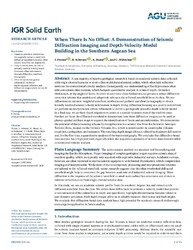When There Is No Offset: A Demonstration of Seismic Diffraction Imaging and Depth-Velocity Model Building in the Southern Aegean Sea
DOI: https://doi.org/10.1029/2020JB019961
Persistent URL: http://resolver.sub.uni-goettingen.de/purl?gldocs-11858/8799
Persistent URL: http://resolver.sub.uni-goettingen.de/purl?gldocs-11858/8799
Preine, J.; Schwarz, B.; Bauer, A.; Hübscher, C., 2020: When There Is No Offset: A Demonstration of Seismic Diffraction Imaging and Depth-Velocity Model Building in the Southern Aegean Sea. In: Journal of Geophysical Research: Solid Earth, Band 125, 9, DOI: 10.1029/2020JB019961.
 |
Dokument öffnen: |
A vast majority of marine geological research is based on academic seismic data collected with single-channel systems or short-offset multichannel seismic cables, which often lack reflection moveout for conventional velocity analysis. Consequently, our understanding of Earth processes often relies on seismic time sections, which hampers quantitative analysis in terms of depth, formation thicknesses, or dip angles of faults. In order to overcome these limitations, we present a robust diffraction extraction scheme that models and adaptively subtracts the reflected wavefield from the data. We use diffractions to estimate insightful wavefront attributes and perform wavefront tomography to obtain laterally resolved seismic velocity information in depth. Using diffraction focusing as a quality control tool, we perform an interpretation-driven refinement to derive a geologically plausible depth-velocity model. In a final step, we perform depth migration to arrive at a spatial reconstruction of the shallow crust. Further, we focus the diffracted wavefield to demonstrate how these diffraction images can be used as physics-guided attribute maps to support the identification of faults and unconformities. We demonstrate the potential of this processing scheme by its application to a seismic line from the Santorini Amorgos Tectonic Zone, located on the Hellenic Volcanic Arc, which is notorious for its catastrophic volcanic eruptions, earthquakes, and tsunamis. The resulting depth image allows a refined fault pattern delineation and, for the first time, a quantitative analysis of the basin stratigraphy. We conclude that diffraction-based data analysis has a high potential, especially when the acquisition geometry of seismic data does not allow conventional velocity analysis.
Statistik:
ZugriffsstatistikSammlung:
Schlagworte:
Aegean Seadepth migration
diffraction imaging
Santorini
tomography
velocity-model building
This is an open access article under the terms of the Creative Commons Attribution-NonCommercial-NoDerivs License, which permits use and distribution in any medium, provided the original work is properly cited, the use is non-commercial and no modifications or adaptations are made.

